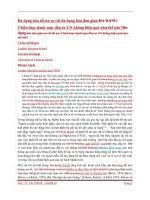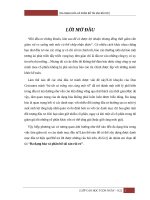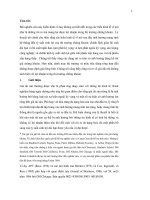Tiểu luận môn đầu tư tài chính the role of expectations in monetary policy
Bạn đang xem bản rút gọn của tài liệu. Xem và tải ngay bản đầy đủ của tài liệu tại đây (1.33 MB, 69 trang )
The role of Expectations in
Monetary Policy
GVHD: TS. Trần Ngọc Thơ
Nhóm :
Đinh Xuân Minh
Hoàng Thị Thu Hà
Content
Lucas Critique of Policy Evaluation
Policy conduct: Rules or Discretion
The role of credibility and a Nominal Anchor
Applications
Approaches to Establishing Central Bank Credibility
Summary
Expandation
Lucas Critique of Policy Evaluation
∗
Economists have long used macroeconometric models to forecast economic
activity and to evaluate the potential effects of policy options.
∗
In essence, the models are collections of equations that describe statistical
relationshops among many economic variables.
∗
Economists can feed data into such models, which then churn out a forecast
or prediction.
Lucas Critique of Policy Evaluation
Econometric Policy Evaluation:
∗
∗
To understand Lucas’s argument, we must first understand how econometric policy
evaluation is done. For example: Federal Reserve wants to evaluate the potential effects
of changes in the federal funds rate from the existing level of 5%.Using conventional
methods, the Fed economists would feed different fed funds rate options—say, 4% and
6%—into a computer version of the model
The model wouldthen predict how unemployment and inflation would change under the
different scenarios. Then, the policymakers would select the policy with the most
desirable outcomes.
Lucas Critique of Policy Evaluation
Econometric Policy Evaluation:
∗
∗
Relying on rational expectations theory, Lucas identified faulty reasoning in this approach
if the model does not incorporate rational expectations, as was true for
macroeconometric models used by policymakers at the time: When policies change,
public expectations will shift as well.
For example, if the Fed raises the federal funds rate to 6%, this action might change the
way the public forms expectations about where interest rates will be in the future. Those
changing expectations, as we’ve seen, can have a real effect on economic behavior and
outcomes
Lucas Critique of Policy Evaluation
Application: The Term Structure of Interest Rates
∗
∗
∗
Let’s now apply Lucas’s argument to a concrete example involving only one equation
typically found in econometric models: the term structure equation.
The term structure equation relates the long-term interest rate to current and past
values of the short-term interest rate.
It is one of the most important equations in macroeconometric models because the longterm interest rate, not the short-term rate, is the one believed to have the larger impact
on aggregate demand.
Lucas Critique of Policy Evaluation
Application: The Term Structure of Interest Rates
∗
∗
In Chapter 6, we learned that the long-term interest rate is related to an average of
expected future short-term interest rates. Suppose that in the past, when the shortterm
rate rose, it quickly fell back down again; that is, any increase was temporary.
Because rational expectations theory suggests that any rise in the short-term interest
rate is expected to be only temporary, a rise should have only a minimal effect on the
average of expected future short-term rates.
Lucas Critique of Policy Evaluation
Application: The Term Structure of Interest Rates
∗
∗
Suppose the Fed wants to evaluate what will happen to the economy if it pursues a policy
that is likely to raise the short-term interest rate from a current level of 3% to a
permanently higher level of 5%. The term structure equation that has been estimated
using past data will indicate that just a small change in the long-term interest rate will
occur.
However, if the public recognizes that the short-term rate is rising to a permanently
higher level, rational expectations theory indicates that people will no longer expect a
rise in the short-term rate to be temporary.
Lucas Critique of Policy Evaluation
Application: The Term Structure of Interest Rates
∗
∗
Instead, when they see the interest rate rise to 5%, they will expect the average of future
short-term interest rates to rise substantially, and so the long-term interest rate will rise
greatly, not minimally as the estimated term structure equation suggests.
The term structure application demonstrates another aspect of the Lucas critique. The
effects of a particular policy depend critically on the public’s expectations about the
policy. If the public expects the rise in the short-term interest rate to be merely
temporary, the response of long-term interest rates, as we have seen, will be negligible.
Lucas Critique of Policy Evaluation
Application: The Term Structure of Interest Rates
∗
∗
The Lucas critique points out not only that conventional econometric models cannot be
used for policy evaluation, but also that the public’s expectations about a policy will
influence the response to that policy.
The Lucas critique should also apply, however, to sectors of the economy for which
rational expectations theory is more controversial, because the basic principle of the
Lucas critique is not that expectations are always rational but rather that the formation
of expectations changes when the behavior of a forecasted variable changes.
Policy Conduct: Rules or Discretion
∗
The Lucas critique exposed the need for new policy models that reflected the insights of
rational expectations theory. Here, we explore the implications of the critique on a long
running debate among economists: whether monetary policymakers should have the
flexibility to adapt their policy to a changing situation, or whether they should adopt
rules, binding plans that specify how policy will respond (or not respond) to particular
data such as unemployment and inflation.
Policy Conduct: Rules or Discretion
Discretion and the Time-inconsistency
∗
∗
Policymakers operate with discretion when they make no commitment to future actions,
but instead make what they believe in that moment to be the right policy decision for the
situation.
The time-inconsistency problem we discussed in Chapter 16 reveals the potential
limitations of discretionary policy. Recall that the time-inconsistency problem is the
tendency to deviate from good long-run plans when making short-run decisions.
Policy Conduct: Rules or Discretion
Discretion and the Time-inconsistency
∗
Policymakers are always tempted to pursue a policy that is more expansionary than firms
or people expect because such a policy would boost economic output (and lower
unemployment) in the short run. The best policy, however, is not to pursue expansionary
policy, because decisions about wages and prices reflect workers’ and firms’
expectations about policy (an implication of the rational expectations revolution).
Policy Conduct: Rules or Discretion
Discretion and the Time-inconsistency
∗
∗
When workers and firms see a central bank, for example, pursuing discretionary
expansionary policy, they will recognize that this is likely to lead to higher inflation in the
future. They will therefore raise their expectations about inflation, driving wages and
prices up.
Policymakers will have better inflation performance in the long run if they do not try to
surprise people with an unexpectedly expansionary policy, but instead keep inflation
under control. One way to do this is to abandon discretion and adopt rules to govern
policy making.
Policy Conduct: Rules or Discretion
Types of Rules
∗
∗
∗
Rules are essentially automatic. One famous type of rule, advocated by Milton Friedman
and his followers who are known as monetarists, is the constant-money-growth-rate
rule, in which the money supply is kept growing at a constant rate regardless of the
state of the economy.
Other monetarists such as Bennett McCallum and Alan Meltzer have proposed variants of
this rule that allow the rate of money supply growth to be adjusted for shifts in velocity,
which has often been found to be unstable in the short run.
Rules of this type are nonactivist because they do not react to economic activity
Policy Conduct: Rules or Discretion
Types of Rules
∗
∗
Activist rules, in contrast, specify that monetary policy should react to the level of output
as well as to inflation. The most famous rule of this type is the Taylor rule, which we
discussed in Chapter 16. It specifies that the Fed should set its federal funds rate target
by a formula that considers both the output gap (Y − YP) and the inflation gap ( - T).
Policy Conduct: Rules or Discretion
The Case for Rules
∗
∗
If monetary policymakers operate with discretion, they will be tempted to pursue overly
expansionary monetary policies to boost employment in the short run but generate
higher inflation (and no higher employment) in the long run.
A commitment to a policy rule solves the time-inconsistency problem because
policymakers have to follow a set plan that does not allow them to exercise discretion
and try to exploit the short-run tradeoff between inflation and employment.
Policy Conduct: Rules or Discretion
The Case for Rules
∗
Another argument for rules is that policymakers and politicians cannot be trusted. Milton
Friedman and Anna Schwartz’s monumental work, A Monetary History of the United
States,4 documents numerous instances in which the Federal Reserve made serious
policy errors, with the worst occurring during the Great Depression, when the Fed just
stood by and let the banking system and the economy collapse (Chapter 9 and Chapter
14 discuss the Fed’s actions during the Great Depression)..
Policy Conduct: Rules or Discretion
The Case for Rules
∗
∗
The politicians who make fiscal policy are also not to be trusted because they have
strong incentives to pursue policies that help them win the next election. They are
therefore more likely to focus on increasing employment in the short run without
worrying that their actions might lead to higher inflation further down the road.
Their advocacy for expansionary policies can then lead to the so-called political business
cycle in which fiscal and monetary policy is expansionary right before elections, with
higher inflation following later.
Policy Conduct: Rules or Discretion
The Case for Rules
Policy Conduct: Rules or Discretion
The Case for Discretion
∗
∗
First, rules can be too rigid because they cannot foresee every contingency. For example,
almost no one could have predicted that problems in one small part of the financial
system, subprime mortgage lending, would lead to the worst financial crisis in over 70
years, with such devastating effects on the economy.
The second problem with policy rules is that they do not easily incorporate the use of
judgment. Monetary policy is as much an art as a science. Monetary policymakers need
to look at a wide range of information in order to decide on the best course for monetary
policy, and some of this information is not easily quantifiable.
Policy Conduct: Rules or Discretion
The Case for Discretion
∗
∗
Third, no one really knows what the true model of the economy is, and so any policy rule
that is based on a particular model will prove to be wrong if the model is not correct.
Discretion avoids the straightjacket that would lock in the wrong policy if the model that
was used to derive the policy rule proved to be incorrect.
Fourth, even if the model were correct, structural changes in the economy would lead to
changes in the coefficients of the model. The Lucas critique, which points out that
changes in policies can change the coefficients in macroeconometric models, is just one
example.
Policy Conduct: Rules or Discretion
The Case for Discretion
Policy Conduct: Rules or Discretion
Constrained Discretion
∗
∗
The distinction between rules and discretion has strongly influenced academic debates
about monetary policy for many decades. But the distinction may be too stark. As we have
seen, both rules and discretion are subject to problems, and so the dichotomy between
rules and discretion may be too simple to capture the realities that macroeconomic
policymakers face.
Discretion can be a relatively undisciplined approach that leads to policies that change
with the personal views of policymakers or with the direction of political winds.
Policy Conduct: Rules or Discretion
Constrained Discretion
∗
∗
Or it might operate within a more clearly articulated framework, in which the general
objectives and tactics of the policymakers—although not their specific actions—are
committed to in advance. Ben Bernanke, now chairman of the Federal Reserve, along with
the author of this textbook, came up with a name for this type of framework, constrained
discretion.
Constrained discretion imposes a conceptual structure and inherent discipline on
policymakers, but without eliminating all flexibility. It combines some of the advantages
ascribed to rules with those ascribed to discretion.









